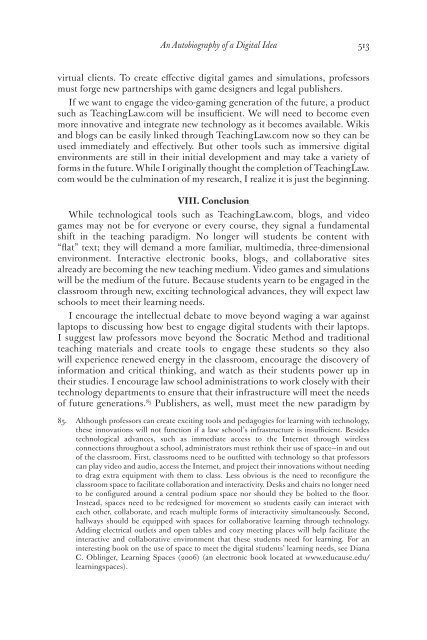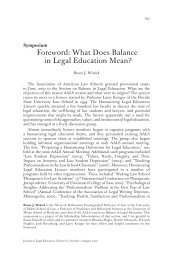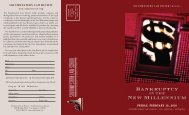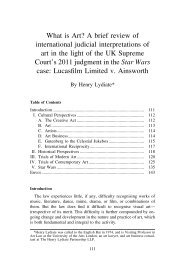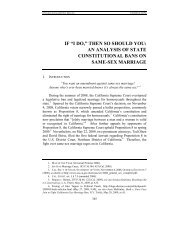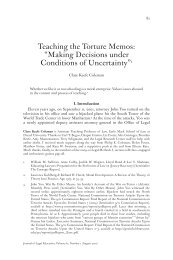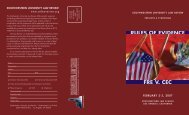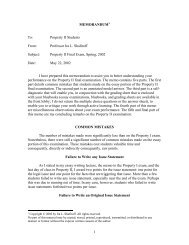An Autobiography of a Digital Idea - Southwestern Law School
An Autobiography of a Digital Idea - Southwestern Law School
An Autobiography of a Digital Idea - Southwestern Law School
You also want an ePaper? Increase the reach of your titles
YUMPU automatically turns print PDFs into web optimized ePapers that Google loves.
<strong>An</strong> <strong>Autobiography</strong> <strong>of</strong> a <strong>Digital</strong> <strong>Idea</strong><br />
513<br />
virtual clients. To create effective digital games and simulations, pr<strong>of</strong>essors<br />
must forge new partnerships with game designers and legal publishers.<br />
If we want to engage the video-gaming generation <strong>of</strong> the future, a product<br />
such as Teaching<strong>Law</strong>.com will be insufficient. We will need to become even<br />
more innovative and integrate new technology as it becomes available. Wikis<br />
and blogs can be easily linked through Teaching<strong>Law</strong>.com now so they can be<br />
used immediately and effectively. But other tools such as immersive digital<br />
environments are still in their initial development and may take a variety <strong>of</strong><br />
forms in the future. While I originally thought the completion <strong>of</strong> Teaching<strong>Law</strong>.<br />
com would be the culmination <strong>of</strong> my research, I realize it is just the beginning.<br />
VIII. Conclusion<br />
While technological tools such as Teaching<strong>Law</strong>.com, blogs, and video<br />
games may not be for everyone or every course, they signal a fundamental<br />
shift in the teaching paradigm. No longer will students be content with<br />
“flat” text; they will demand a more familiar, multimedia, three-dimensional<br />
environment. Interactive electronic books, blogs, and collaborative sites<br />
already are becoming the new teaching medium. Video games and simulations<br />
will be the medium <strong>of</strong> the future. Because students yearn to be engaged in the<br />
classroom through new, exciting technological advances, they will expect law<br />
schools to meet their learning needs.<br />
I encourage the intellectual debate to move beyond waging a war against<br />
laptops to discussing how best to engage digital students with their laptops.<br />
I suggest law pr<strong>of</strong>essors move beyond the Socratic Method and traditional<br />
teaching materials and create tools to engage these students so they also<br />
will experience renewed energy in the classroom, encourage the discovery <strong>of</strong><br />
information and critical thinking, and watch as their students power up in<br />
their studies. I encourage law school administrations to work closely with their<br />
technology departments to ensure that their infrastructure will meet the needs<br />
<strong>of</strong> future generations. 85 Publishers, as well, must meet the new paradigm by<br />
85. Although pr<strong>of</strong>essors can create exciting tools and pedagogies for learning with technology,<br />
these innovations will not function if a law school’s infrastructure is insufficient. Besides<br />
technological advances, such as immediate access to the Internet through wireless<br />
connections throughout a school, administrators must rethink their use <strong>of</strong> space—in and out<br />
<strong>of</strong> the classroom. First, classrooms need to be outfitted with technology so that pr<strong>of</strong>essors<br />
can play video and audio, access the Internet, and project their innovations without needing<br />
to drag extra equipment with them to class. Less obvious is the need to reconfigure the<br />
classroom space to facilitate collaboration and interactivity. Desks and chairs no longer need<br />
to be configured around a central podium space nor should they be bolted to the floor.<br />
Instead, spaces need to be redesigned for movement so students easily can interact with<br />
each other, collaborate, and reach multiple forms <strong>of</strong> interactivity simultaneously. Second,<br />
hallways should be equipped with spaces for collaborative learning through technology.<br />
Adding electrical outlets and open tables and cozy meeting places will help facilitate the<br />
interactive and collaborative environment that these students need for learning. For an<br />
interesting book on the use <strong>of</strong> space to meet the digital students’ learning needs, see Diana<br />
C. Oblinger, Learning Spaces (2006) (an electronic book located at www.educause.edu/<br />
learningspaces).


